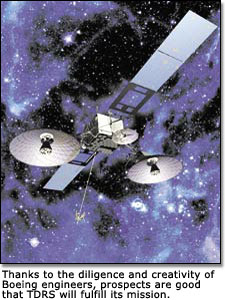|
Creativity fuels TDRS-I recovery
A team of Boeing engineers simply
would not give up
BY JOEL R. NELSON

 Things
looked bleak for NASA's TDRS-I satellite a few months ago when a propulsion
system malfunctioned. Things
looked bleak for NASA's TDRS-I satellite a few months ago when a propulsion
system malfunctioned.
But now, thanks to an innovative solution from Boeing Satellite Systems
employees, program managers believe prospects are good that the Tracking
and Data Relay System satellite will fulfill its mission.
The Boeing 601 model's launch on March 8, 2002, went smoothly, but the
initial jubilation that accompanied the spacecraft's separation from its
Atlas IIA launch vehicle was soon dampened by the discovery of a propulsion
system malfunction. (The satellite's other systems were, and are, functioning
normally.)
Not only did the problem jeopardize TDRS, a critical link in NASA's space-based
communications capabilities, it generated widespread media coverage that
strongly implied a total satellite failure.
"Not so fast!" said a team of about 35 Boeing Satellite Systems engineers
that crafted a solution to restore the satellite's health and place the
TDRS-I in its proper orbit.
They found the lower-than-expected pressure in one of its two propulsion
tanks was caused by an improperly closed valve at the top of one tank
that impeded the flow of helium, used to push propellant out of the tank.
This situation was found to be unique to TDRS-I and not an issue for the
Boeing 601 fleet.
The team's solution: Since both tanks can't be emptied concurrently, the
team will clear out the good tank over a two-week period, then access
the propellant in the faulty tank from the bottom — normally an outlet,
not an intake valve — by providing pressure via a fuel line from
the first tank.
"The procedure is similar to a coronary bypass," said Jon Goodney, Boeing
Satellite Systems' TDRS-I Program Manager. "One ‘artery' doesn't
work, so we'll route the ‘blood' via another artery." He said the
rough concept was in place early on, "but the devil is in the details.
It's a very complicated problem that required a lot of simulations and
tests using stand-in tanks and thrusters on the ground."
TDRS-I's placement into its final orbit is expected by early August, followed
by a checkout procedure lasting about two months.
|